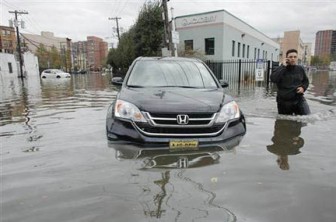NEW YORK, (Reuters) – New York City and the sodden U.S. Northeast began an arduous journey back to normal yesterday after mammoth storm Sandy killed at least 64 people in a rampage that swamped coastal cities and cut power to millions.

Financial markets reopened with the New York Stock Exchange running on generator power after the first weather-related two-day closure since an 1888 blizzard. Packed buses took commuters to work with New York’s subway system halted after seawater flooded its tunnels.
President Barack Obama, who has halted campaigning with the election six days away, set aside political differences with New Jersey Republican Governor Chris Christie for a helicopter tour of the devastated coast, where they saw flooded and sand-swept neighborhoods and burning homes.
“The entire country’s been watching. Everyone knows how hard Jersey has been hit,” Obama told residents at an evacuation shelter in the town of Brigantine.
“We’re not going to tolerate any red tape. We’re not going to tolerate any bureaucracy,” he said of the relief effort.
Sandy crashed ashore with 80 mile-per-hour (130-kph) winds on Monday as a rare hybrid superstorm after merging with another system. It was the largest storm by area to hit the United States in generations, after killing 69 people as a hurricane in the Caribbean.
Sandy was likely to rank as one of the costliest storms in U.S. history. One disaster-modeling firm said Sandy may have caused up to $15 billion in insured losses.
About 6 million homes and businesses in 15 U.S. states remained without power on Wednesday, down from a high of nearly 8.5 million, which surpassed the record 8.4 million customers who went dark from last year’s Hurricane Irene.
While markets reopened, floodwaters receded and residents went back to work by car, bicycle and bus in New York, the country’s most populous city suffered some setbacks. Damage forced evacuation of Bellevue Hospital, known for psychiatric and emergency care.
Five hundred patients were being moved, Mayor Michael Bloomberg said. Evacuations of four other hospitals and 17 chronic care facilities had already been ordered.
An evacuation order for 375,000 New Yorkers in low-lying areas remained in effect. With subways down, the mayor said cars must have at least three passengers to enter Manhattan.
Across the Hudson River in Hoboken, New Jersey, water that reached chest high on Monday was knee high on Wednesday morning.
“I thought it was the end. I kept telling my sons to pray,” said Marcelina Rosario, 47, who was trapped in the second floor of her Hoboken apartment. “Everything happened so fast. The water started coming up, the refrigerator was floating.”
In Point Pleasant Beach, New Jersey, a few hundred people strolled the storm-shattered boardwalk on Wednesday, stepping around piles of broken boards, sand and debris as crews used heavy equipment to clear 2 feet (60 cm) of sand from nearby streets.
More than half of all the gas stations in the New York City area and New Jersey were closed due to power outages and depleted fuel supplies, frustrating attempts to restore normal life, industry officials said.
Tempers flared and horns blared in a line of some 30 cars at a Getty service station in Gowanus in the New York City borough of Brooklyn. “I don’t have any lights and need this gasoline for my generator,” said Abdul Rahim Anwar as he put two full jerry cans into his trunk.
The New York area’s John F. Kennedy and Newark airports reopened after thousands of flights had been canceled, leaving travelers stuck for days. LaGuardia, a third major airport, was scheduled to reopen on Thursday.
Limited New York subway service was due to start today, four days after the system, with daily traffic of about 5.5 million people, shut down.
Brooklynite Matthew Gessler went to Breezy Point, the New York neighborhood where fire destroyed 111 homes, to inspect damage to his mother’s house, and was disturbed by what he saw.
“Where the fire happened, you could honestly take that picture and say it was somewhere in the Middle East, like in Afghanistan, and no one would doubt you at all,” said Gessler, 35. “There were houses that just got picked up and washed away. So you’d be walking down the street and there’d be a house in the middle of the street.”
Queens District Attorney Richard Brown said more than a dozen people had been charged with theft and looting in connection with the storm for targeting businesses in the badly flooded Far Rockaway neighborhood of the New York City borough.









